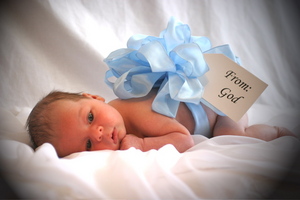I am a registered nurse, however, nothing I learned about life and death prepared me for the death of my twin son in 1979. I was 29 years old that year and thrilled to learn, at five months pregnant, that I was carrying twins. Like most expectant mothers, I loved my pregnancy. I sang to my babies while they were in my womb. I took photographs of my expanding belly. I dreamed what my life would be like with two babies to care for at the same time. I had a baby shower for twins. I had two of everything. I owned my own home. I had a job I loved and a loving partner. Life was wonderful.
Finally the day arrived when I went into labor. I had seen the doctor earlier in the week. He determined that one baby was a footling breech and the other baby was lying transverse across my abdomen. He told me to prepare for a Cesarean Section as the liklihood of the babies turning head down was remote. I was 38 weeks pregnant when my bag of water suddenly broke that early Saturday morning. While stunned at first, I excitedly woke my partner with the news. We went to the hospital as instructed.
At last my babies would be born. I didn’t have to worry about prematurity, so common in twin births, since the babies had reached full term. I was put into a wheelchair and taken up to the maternity unit. They were ready for me. They quickly checked my labor progress. I was dilated to 4 centimeters and they could feel a foot! The doctor was right. I needed a Cesarean Section. Next came surgical permits for anesthesia (a spinal, so I would be awake) and surgery. The nurses were in a hurry, starting my IV, putting me on the fetal monitor, and monitoring my contractions. Two pediatricians would be in attendance, one for each baby. I was asked what I wanted: two girls? Two boys? A girl and a boy? The fetal heart rate monitor showed both heartrates, although the nurse had some difficulty recording the heartrate of “baby #2.
The next thing I knew I was in the operating room. Everyone was happy. My daughter was born! She gave a lusty cry. Tears filled the corners of my eyes at the knowledge that she was alright. I always wanted a daughter. We named her Kate. I was filled with so much joy. I’ll never forget the next thing I heard. The surgeon said “This one has meconium”. I knew the presence of meconium in the amniotic fluid was a sign of fetal distress. I kept asking if the baby was out yet. No answer. I asked if the baby was alright. No answer. You could hear a pin drop. No one was talking to me. “It’s a boy” the doctor said. “Why doesn’t he cry”? I asked. Finally someone said “we are working on him”. All I could do was keep asking if he was alright. No one said a word. I asked ” Will someone tell me how he is”?
The pediatrician came up to my face to talk to me. He said “I’m sorry to tell you that your little boy has died”. I couldn’t believe it. I asked them to transfer the baby to intensive care. How could this happen to me and my baby? I ate all the right foods. I exercised daily. I didn’t smoke or drink. I began to sob. Someone said to bring my daughter over for me to look at. She was beautiful, pink, healthy and I loved her, but I wanted both babies.
It was January 1979. We were a death denying society. When pregnancy failed, mother’s were told “You can always have another baby”. This was not helpful. It did not make me feel any better. I wanted my son back.
I slid into a deep depression as my mind tried to accept my new normal…a life without my son. Every waking moment, every breath I took, was painful. It would remain so for many months to come.
I remember being put in a room at the end of the hall, farthest away from the nursing station. I felt like the nursing staff were avoiding me because I failed. When I asked to see my son, I was told I couldn’t because he was in the morgue. I persisted. I finally was given permission to see him. He was limp, blue and cold to the touch. He weighed 6 pounds, 8 ounces. He had blonde hair and blue eyes. He had all his fingers and toes and looked so perfect. What happened to him? How could my body betray me? When I am getting sick, my body lets me know. How come it didn’t let me know my baby was dying? After about 15 minutes, I was told I needed to give him back. I had to say goodbye. I wanted more time with him. I was told “There will never be enough time. You will always want more”. They took him away.
Because I had twins, many people remarked “Well at least you had one baby to bring home” or “I’m sorry God took your little boy but left you with a little girl to ease the pain”. My own mother, a few days after the twins were born, said to me “You have a daughter to take care of. You need to put this behind you and move on”. It is important to avoid interjecting your own values in your attempt to console . Many well meaning friends may say “You now have an angel in heaven”. Refrain from using these kind of comments. They can cause more pain. At times, they can present a problem to the family far worse than the diagnoses itself. These attitudes are a mirror into the soul of the society we live in. A society that tries to hide death’s impact. In my case, what they all failed to acknowledge was that I expected to bring home two babies, not one. My nursery was setup for two babies. My life and my heart were ready for twins. I needed permission to grieve.
Losing a twin is a roller coaster ride of joy and despair. It is a schizophrenic existance. I loved my daughter but I grieved for my son. I had to sign her birth certificate. I had to sign his death certificate. I had to send out birth announcements. I had to include an explanation that my second baby did not survive. I took my daughter home. I had to leave my son behind.
I was not approached by a grief counselor, social worker, or clergyman. When I asked to see my baby again later that evening, the nurses reacted with blank looks on their faces. They couldn’t believe I wanted to see him again. At first they refused. Finally they said it would be alright but “only for a few minutes and this would be the last time”.
31 years have passed since my dreams of life with my twins came to an end. One never gets over the loss of a child. It goes against the natural order of things. We are not supposed to outlive our children. The heartache never goes away completely but ebbs and flows. You have to learn to live with the loss. Recently, a family member remarked that she forgot I even had twins. I was shocked to hear this. I have never forgotten. The statistics say that 1 in 200 live births end up in stillbirth or newborn loss. Certainly the odds for a healthy outcome are in the mother’s favor, but if she is the “1”, then statistics mean nothing.
When my daughter was 3 years old, I returned to hospital nursing. I took a job working on a maternity unit. My experience with Jason taught me how to be with grieving families. Losing him gave me a more compassionate heart. Perhaps that was part of the purpose and legacy of his short life.
Dr. Arthur Kleinman in The Illness Narratives: Suffering, Healing & the Human Condition states “the moral lesson illness teaches is that there are undesired and undeserved pains that must be lived through”. Grief and mourning are chronic illnesses. While living with the loss gets easier with time, the pain stays with you. It is a life sentence.
The medical profession now recognizes the impact of losing a baby. The social fabric of support has completely changed. What aids the grieving family?
Parents are emotionally supported through our social workers and grief counselors. Nursing staff attend conferences where they learn how to deal with grieving families. The babies are tenderly bathed . They are kept warm under radiant heaters. They are carefully dressed in blue or pink outfits knitted by volunteers. Even the smallest premature baby will have a new outfit to wear. Families are encouraged to name their babies. Hold them as long as they want. Take pictures. Invite siblings and grandparents into the room to say goodbye. For years to come, families will tell us how much it meant to have time alone with their baby. Where this was once seen as grotesque and morbid, it is now seen as completely normal and even desirable. Seeing and holding ones’ infant, recognizing familial traits, counting toes and fingers, are all ways of making the imagined child real. Grief support staff will make molds of tiny hands and feet as a loving momento for these bruised and fragile families. A memory box is given to each mother, with the knitted outfit the baby wore folded inside. It gives the parents something tangible to take home.
We are now acknowledging the rights of grieving families. Even after viewing, the baby is recovered tenderly with the same respect that would be shown a live infant. Requests for repeated viewings are considered normal. No judgments are made.
Parents need a sympathetic and empathetic listening ear. Saying that you are sorry for their loss is appropriate and appreciated. Don’t be afraid that bringing up the subject will make them cry. You haven’t made them cry. The loss of their baby makes them cry. Those tears are a healthy sign that the pain in their hearts has found some release. Parents need to tell their story. It is the beginning of healing. Will you listen?
Reference:
- The Forgotten Grief: Stillbirth, Neonatal Death & Perinatal Bereavement
- Kleinman, Arthur. The Illness Narratives: Suffering, Healing & the Human Condition, 1989




